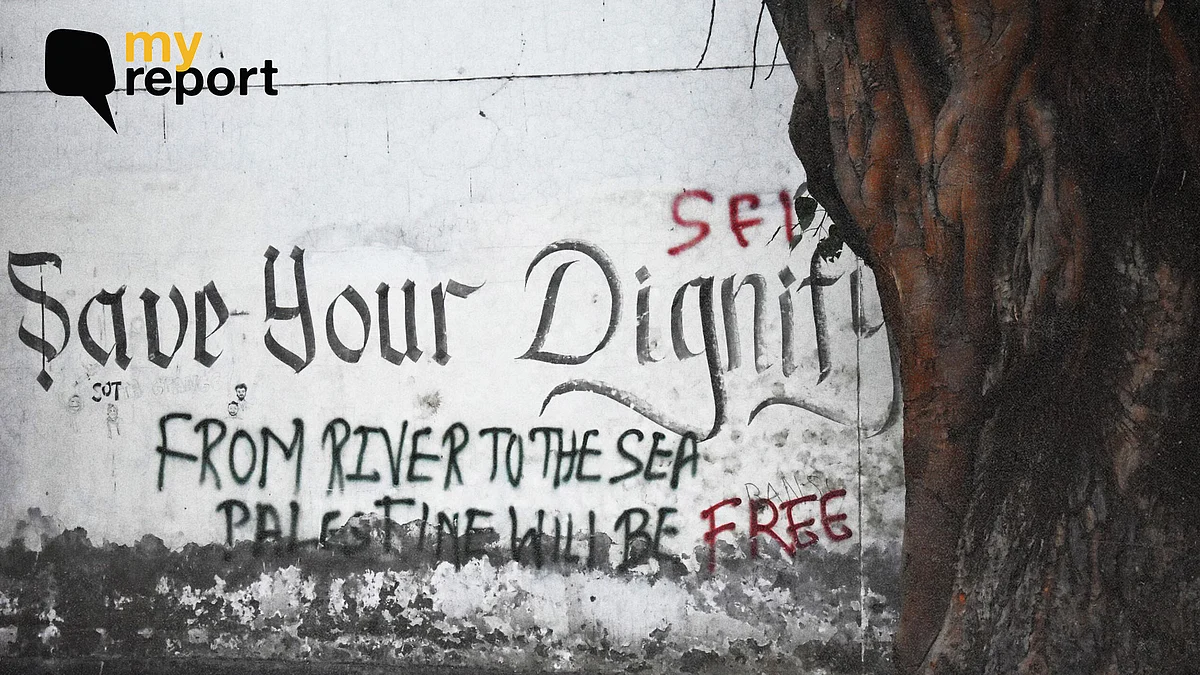
In Photos: The Stories That Delhi's Murals Tell
With growing curtailment of freedom of expression in traditional mediums, art becomes a safe space for free speech.

advertisement
Amid the vibrant streets of Lodhi Art District at Delhi's Lodhi Colony, a mural of a Bansuriwala and a sweet shop known as Impressions of Lodhi, towers as a massive spectacle in open display. Painted by a Singaporean artist, Yip Yew Chong, the vibrancy and the grandeur of the mural invites people to reflect on its story.
(Photo Credit: Unzila Sheikh and Maryam Hassan)
Several kilometers away, tucked within a narrow stairwell at the Jamia Millia Islamia's campus, the inscription of Faiz Ahmed Faiz’s famous verse, "Bol Ki Lab Azad Hain Tere" (Say, that your lips are free to speak) is starting to fade. Although differing in location and preservation, both the pieces serve as a platform of expression, offering a peep into Delhi’s wall arts.
(Photo Credit: Unzila Sheikh and Maryam Hassan)
From Paleolithic cave paintings to the origin of graffiti in the urban West, wall art has always reflected the intersection of creativity and dissent. Similarly, walls in Delhi have served as powerful canvases for expression.
(Photo Credit: Unzila Sheikh and Maryam Hassan)
Devoting artistic output to political causes, resistance art has always found a space in society. "Words fade, but art does not. They can shut their ears, but they cannot shut their eyes," says Shah Kulsum Shaikh, a student of fine arts, who led the wall paintings and graffiti scene at Jamia Millia Islamia during the anti-CAA protests.
(Photo Credit: Unzila Sheikh and Maryam Hassan)
With a growing curtailment of freedom in traditional mediums, one would count art as a safe space for freedom of speech to thrive. An example of this is the narrow alleyways of Majnu Ka Tila. In a time when the global momentum for the Free Tibet movement has faded, the walls stand as a silent yet powerful symbol of resistance against decades of occupation.
(Photo Credit: Unzila Sheikh and Maryam Hassan)
In university spaces across Delhi, art is consistently used as a silent means of protest. Mariya, a student of MA English at Jawaharlal Nehru University, says, "Educational institutes have always been a very strong voice of dissent. This happens because education makes one visualise a better world by realising the faults of the current one."
(Photo Credit: Unzila Sheikh and Maryam Hassan)
"If you don't stand for something, you can fall for everything" – a quote by Malcolm X adorns a wall as Birsa Ambedkar Phule Students' Association (BAPSA) advocates for the Mandal Commission.
(Photo Credit: Unzila Sheikh and Maryam Hassan)
All India Students' Association's (AISA) graffiti urging students to move beyond isolation and into collective resistance.
(Photo Credit: Unzila Sheikh and Maryam Hassan)
With its roots in defiance and opposing power systems, resistance art constantly faces institutional threats in the form of whitewashing, defacement, and penalties. Shah Kulsum Shaikh solidifies this statement by highlighting her experience during the CAA protests: "I faced a lot of threats and moral policing... our work was wiped out and even blackened while we were still painting it."
(Photo Credit: Unzila Sheikh and Maryam Hassan)
The most recent example of this curtailment comes in the form of a notice by the property department of Jamia that equates any type of writing, painting, or posters with vandalism under Section 324 of the Bharatiya Nyaya Sanhita (BNS) if put up without permission. "This notice is emblematic of a broader tendency within institutions to frame dissent as something inherently disruptive rather than a form of engagement or dialogue," says Kulsum.
(Photo Credit: Unzila Sheikh and Maryam Hassan)
Instead of stifling expression, Kulsum highlights the need for spaces where institutional decorum and creative resistance can coexist. "The streets will always belong to the people, no matter how many notices or fines are issued," she adds.
(Photo Credit: Unzila Sheikh and Maryam Hassan)
The other side of Delhi’s wall art is dedicated to displaying identity and imagination through decorative works that aim to beautify rather than confront. The walls of urban spaces like Hauz Khas and the Lodhi Art District today carry a personal mark.
(Photo Credit: Unzila Sheikh and Maryam Hassan)
The wide streets and housing blocks of Lodhi Art District exemplify this diversity. An initiative by the St+art India Foundation displays themes ranging from aesthetic beauty to simple truths about life. According to a 2024 report by The Hindu, the gallery has about 65 murals by Indian and international artists. These range from semi-mythological beings and surrealist creatures to calligraphic styles and portraits.
(Photo Credit: Unzila Sheikh and Maryam Hassan)
The motivations behind these decorative works are as varied as the murals themselves. "The inspiration behind my work usually comes from my personal observance and thoughts," says Aftab Ahmed, a graffiti artist based in Delhi who goes by the name Manmauji.
(Photo Credit: Unzila Sheikh and Maryam Hassan)
Despite the differences, there are instances where the line between decorative and dissent art blurs. Manmauji, who also contributed to the CAA and NRC protest murals, explains, “While my work is primarily inclined towards decorative art, I always try to incorporate themes, avoiding abstract ideas. Some of these themes often touch upon an underlying tone of dissent.”
(Photo Credit: Unzila Sheikh and Maryam Hassan)
(Unzila Sheikh and Maryam Hassan are first-year Convergent Journalism students at Jamia Millia Islamia, New Delhi.)
(All 'My Report' branded stories are submitted by citizen journalists to The Quint. Though The Quint inquires into the claims/allegations from all parties before publishing, the report and the views expressed above are the citizen journalist's own. The Quint neither endorses nor is responsible for the same.)
- Access to all paywalled content on site
- Ad-free experience across The Quint
- Early previews of our Special Projects
Published: undefined